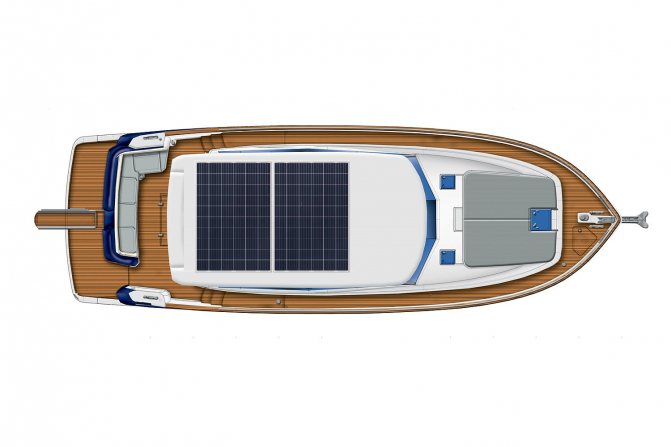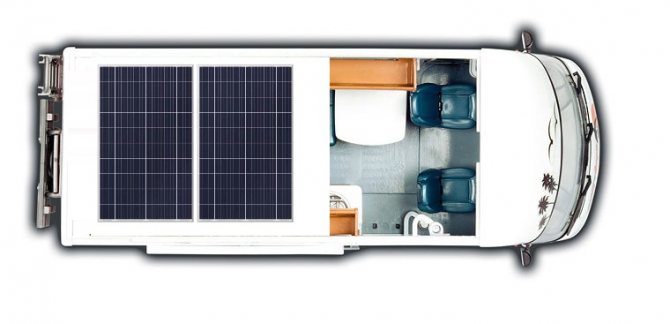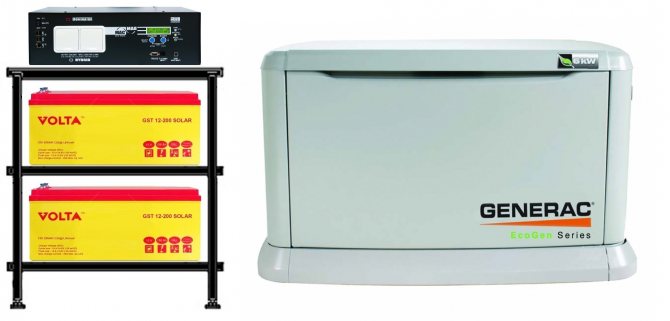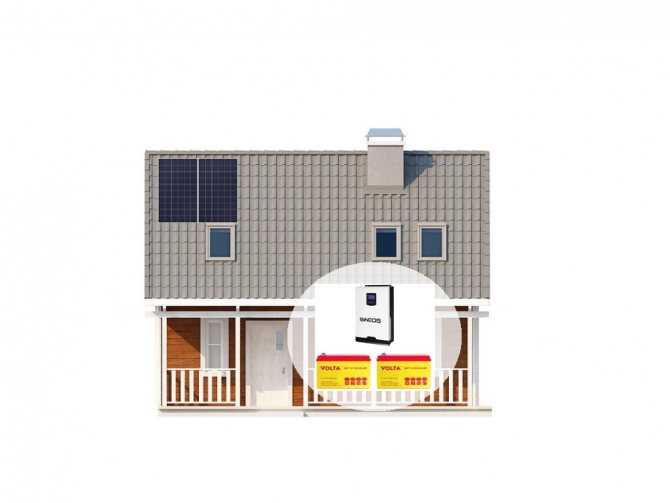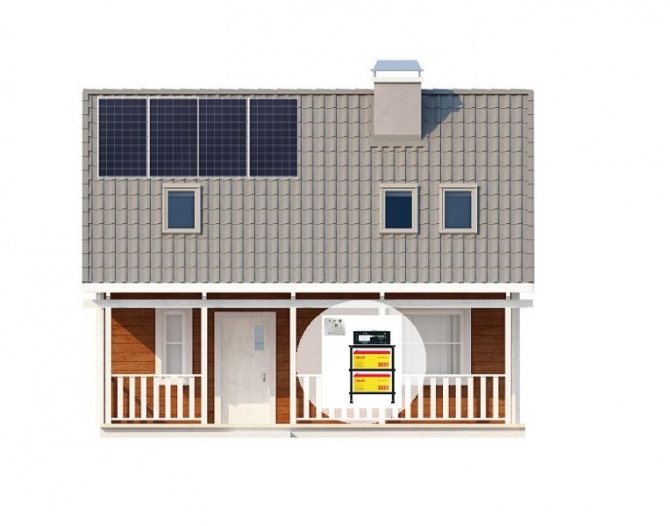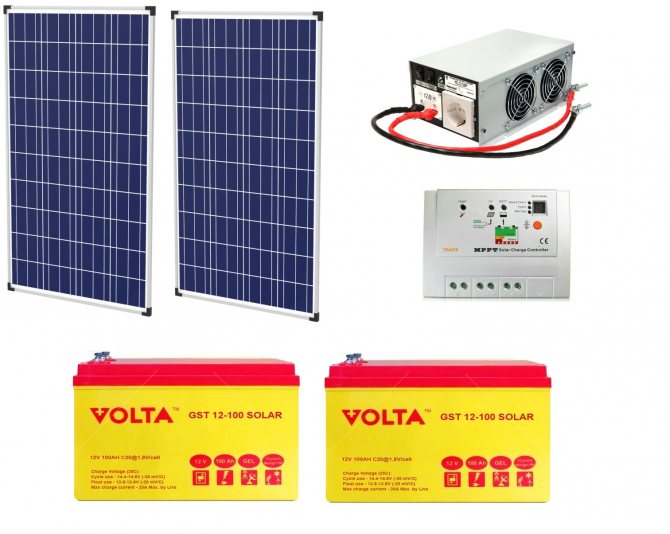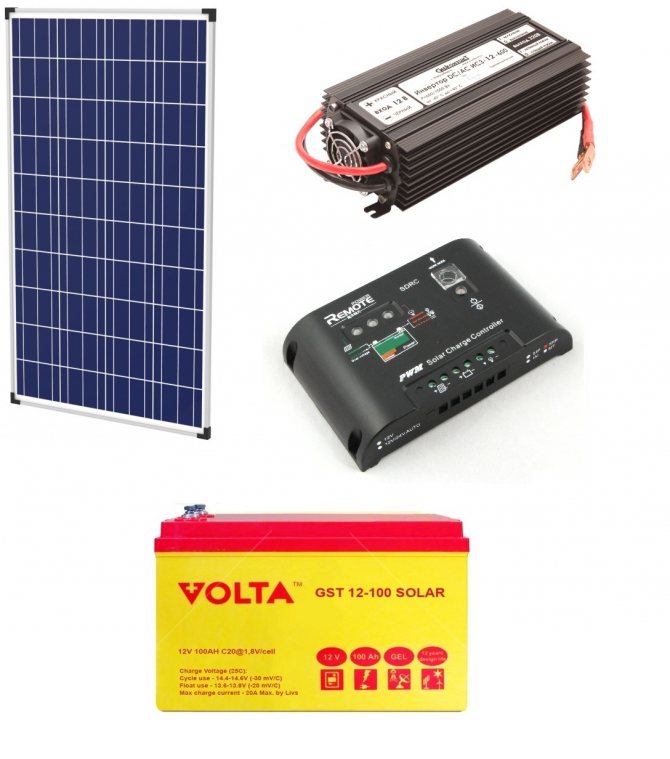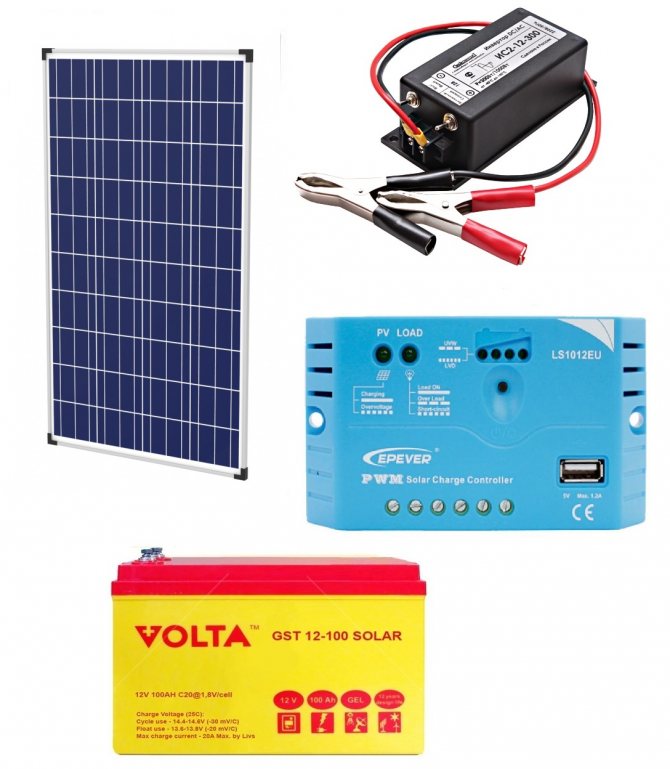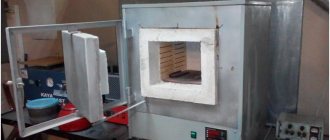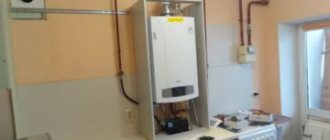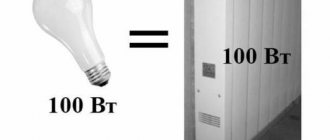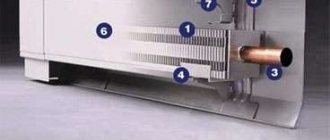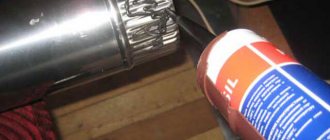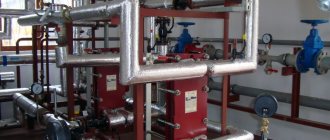Alkaline batteries
Unlike acidic ones, alkaline batteries do an excellent job with deep discharge and are capable of delivering currents for a long time by about 1/10 of the battery capacity. Moreover, it is strongly recommended to discharge alkaline batteries completely so that the so-called "memory effect" does not occur, which reduces the capacity of the battery by the amount of the "unselected" charge.
In comparison with acidic ones, alkaline batteries have a significant - 20 years or more - service life, give a stable voltage during the discharge process, can also be serviced (flooded) and unattended (sealed) and, it seems, are simply created for solar energy. In fact, no, because they are not able to charge the weak currents that solar panels generate. A weak current flows freely through the alkaline battery without filling the battery. Therefore, alas, the lot of alkaline batteries in autonomous power systems is to serve as a "bank" for diesel generators, where this type of storage is simply irreplaceable.
Operation of inverters with alternative backup power supplies
Modern power inverters, together with batteries, allow for the autonomous operation of all household appliances through the use of alternative power supply sources. In this case, in addition to the generator, solar panels and a wind generator are included in the hybrid system. Also, the backup power supply system can only function with renewable energy sources.
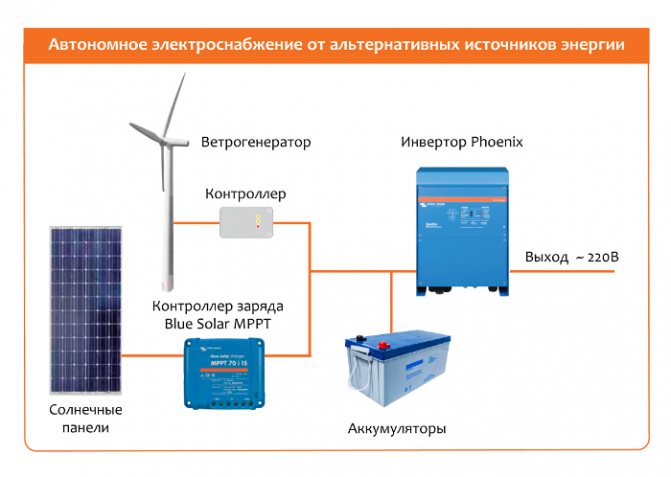
The energy of the sun or wind can be stored in batteries using special charge controllers when it is available. With a sufficient battery charge, inverters convert the direct current of the batteries into alternating current with a pure sine wave, which is used to maintain the operability of household appliances and equipment.
Another option for using inverters is the construction of uninterruptible power systems in situations where there is a connection to the network, but not stable. In this situation, an autonomous power source based on inverters with batteries and solar panels is used not only in the event of a power failure in the stationary network, but also for the priority use of solar energy in order to save network electricity.
For work with alternative energy sources: solar panels and wind turbines, inverters from the Victron Phoenix Inverter series from 1.2 kVA to 5 kVA are well suited.
The Victron Phoenix series inverter is a professional DC to AC conversion device. Designed with hybrid RF technology, it is designed to meet the highest demands. Its function is to provide power to any autonomous power supply system with the need to obtain high quality output current with a stable voltage in the form of a pure sine wave. In everyday life, voltage with a pure sine is required by such devices as a gas boiler, refrigerator, microwave oven, TV, washing machine, and so on.
Completely autonomous power supply of a private house with various household electrical appliances requires both high quality voltage and the ability of the inverter to cope with inrush currents of difficult loads (refrigerator compressor, pump motor, etc.). Phoenix's SinusMax function can meet this need.It provides twice the short-term overload capacity of the system. Simpler and earlier voltage conversion technologies cannot do this.
Inverter power consumption:
- idling: from 8 to 25 W depending on the model;
- in load search mode: from 2 to 6 W, this mode is accompanied by the system turning on regularly every two seconds for a short period of time.
- Continuous operation in power saving mode (AES): 5 to 20 watts.
Autonomous power supply systems allow for their own control and monitoring by connecting the inverter to a computer. Victron Energy has developed the VEConfigure software for its inverters. Connection is via MK2-USB interface.
Phoenix Inverter and Phoenix Inverter Compact inverters can operate in parallel configurations (up to 6 inverters per phase) or in 3-phase configurations. Optimal in terms of price / quality ratio, they are suitable not only for home, but also for autonomous power supply of vehicles, mobile complexes.
Li-ion batteries
Batteries of this type have a fundamentally different "chemistry" than batteries for tablets and laptops, and use the lithium iron phosphate reaction (LiFePo4). They charge very quickly, can give up to 80% of the charge, do not lose capacity due to incomplete charging or long storage in a discharged state. Batteries withstand 3000 cycles, have a service life of up to 20 years, and are also produced in Russia. The most expensive of all, but in comparison with, for example, acidic ones, they have twice the capacity per unit of weight, that is, they will need half as much.
Solar panels DELTA, EXMORK, solar controllers, inverters and uninterruptible power supplies (UPS), including the most popular ones with pure sine output, DELTA, MNB and HAZE batteries. All these components necessary for the manufacture of solar power plants and backup power systems can be purchased in our CLEAN ENERGY store.
Our SUN is an inexhaustible, free and environmentally friendly source of energy. Every hour, a huge amount of energy enters our planet with the sun's rays. To convert solar energy into electrical energy, this task is performed by a solar battery. Solar panels have a lifespan of at least 30 years. They are produced at high-tech factories in China, each product is tested and tested for electrical characteristics. DC voltage from the solar panels is fed to the battery via the solar controller and charges it. Solar controllers are needed to ensure long-term and reliable battery performance. Its main functions are overcharge prevention, maintenance charge, prevention of reverse current through solar panels at night, temperature compensation of the charge current and many other functions useful for the battery and for general energy saving. DELTA GEL batteries are most suitable for autonomous solar and wind power systems due to their low self-discharge current, deep discharge tolerance and the possibility of installation in residential premises. It is already possible to remove 12, 24, 48 Volts from storage batteries to consumers or using a 220V inverter. The DC AC inverter converts the constant voltage of the storage battery into the alternating voltage, familiar to us 220V.
For power backup, as a UPS for gas boilers and other critical loads, only converters with a pure sine at the output are used. Russian Energia, which additionally have a built-in stabilizer and an informative display, have proven themselves very well in this role. From the online UPS, the Chinese Tieber, still under the Zenon Ultra 1000lt brand, works perfectly, this uninterruptible power supply will satisfy the needs of the most demanding customer.Batteries for UPS are selected based on operating conditions, if light outages occur often and for a long time, then it is better to opt for the GX and DTM series, if 2-4 times a month, and the battery currents are small, the DT series is quite suitable
Main technical characteristics of the battery
The characteristics and requirements for batteries are determined based on the characteristics of the operation of the solar power plant itself.
Batteries must:
- be designed for a large number of charge-discharge cycles without significant loss of capacity;
- have a low self-discharge;
- maintain performance at low and high temperatures.
The key characteristics are considered to be:
- battery capacity;
- full charge and permissible discharge rate;
- conditions and service life;
- weight and dimensions.
How to calculate and choose the right battery
Calculations are based on simple formulas and tolerances for losses that arise in an autonomous power supply system.
The minimum supply of energy in the batteries should provide the load in the dark. If from dusk to dawn the total energy consumption is 3 kWh, then the battery bank must have such a reserve.
The optimal energy supply should cover the daily needs of the facility. If the load is 10 kW / h, then a bank with such a capacity will allow you to “sit out” 1 cloudy day without any problems, and in sunny weather it will not discharge by more than 20-25%, which is optimal for acid batteries and does not lead to their degradation.
Here we do not consider the power of solar panels and take it for the fact that they are able to provide such a charge to batteries. That is, we are building calculations for the facility's energy needs.
The energy reserve in 1 battery with a capacity of 100 Ah with a voltage of 12 V is calculated by the formula: capacity x voltage, that is, 100 x 12 = 1200 watts or 1.2 kW * h. Therefore, a hypothetical object with a night consumption of 3 kW / h and a daily consumption of 10 kW / h needs a minimum bank of 3 batteries and an optimal one of 10. But this is ideal, because you need to take into account the allowances for losses and equipment features.
Where energy is lost:
50% - permissible discharge level conventional acid batteries, so if the bank is built on them, then there should be twice as many batteries as a simple mathematical calculation shows. Batteries optimized for deep discharge can be “drained” by 70–80%, that is, the capacity of the bank should be higher than the calculated one by 20–30%.
80% - average efficiency of an acid battery, which, due to its peculiarities, gives off energy 20% less than it stores. The higher the charge and discharge currents, the lower the efficiency. For example, if an electric iron with a power of 2 kW is connected to a 200Ah battery through an inverter, the discharge current will be about 250A, and the efficiency will drop to 40%. Which again leads to the need for a two-fold reserve of the bank's capacity, built on acid batteries.
80-90% - average efficiency of the inverter, which converts DC voltage into AC 220 V for the household network. Taking into account energy losses, even in the best batteries, the total losses will be about 40%, that is, even when using OPzS and even more so AGM batteries, the capacity reserve should be 40% higher than the calculated one.
80% - the efficiency of the PWM controller charge, that is, solar panels will physically not be able to transfer to batteries more than 80% of the energy generated on an ideal sunny day and at the maximum rated power. Therefore, it is better to use more expensive MPPT-controllers, which ensure the efficiency of solar panels up to 100%, or to increase the battery bank and, accordingly, the area of solar panels by another 20%.
All these factors must be taken into account in the calculations, depending on what constituent elements are used in the solar generation system.
Batteries as an escape from the dark
Batteries are always needed in the household of a large house. This is especially true for a country house during a power outage. Power outages are more common in rural areas than in cities. There are many explanations for this phenomenon, but for residents of private houses it is better not to delve into causal relationships, but to stock up on a ready-made solution - batteries.
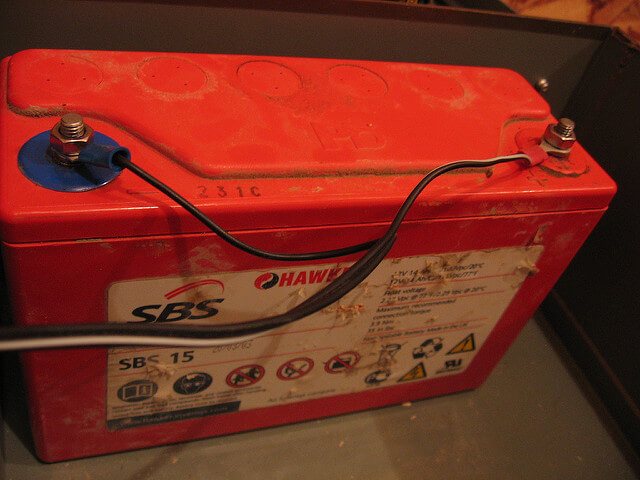

As a temporary measure in the event of a power outage, conventional car batteries are suitable.
However, you need a lot of them, so it is better to use special high-power batteries designed to work with deep discharge. The most acceptable for such purposes are lead-acid batteries, which are produced both in a hermetically sealed version and with a liquid electrolyte. They are simple and inexpensive. The industry also produces nickel-cadmium batteries. They are more expensive but last longer.
Gel batteries are even more expensive, which does not prevent them from being popular with owners of suburban real estate. The name comes from the electrolyte in a gel state. The gelatinousness of the electrolyte comes from the silica additive. This makes the batteries more viable and longer lasting.
If you have frequent and long-term power outages, it is better to buy these particular batteries.
Batteries intended for the energy needs of a country house must have the following properties.
- Have small weight and dimensions. This is usually achieved by dividing the device into several easily portable sections.
- Charge quickly from a 220 V mains.
- Have the ability to connect to autonomous generators (solar, wind, hydro, etc.)
- Have a capacity that allows you to connect separately to household appliances or lighting systems.
- The ability to form a battery from several batteries.
Battery operating rules
Serviced batteries emit gases during operation, therefore it is forbidden to place them in residential premises and it is necessary to equip a separate room with active ventilation.
The electrolyte level and the depth of charge must be constantly monitored to avoid battery damage.
With year-round operation, in order to avoid deep discharge of batteries on cloudy days, it is necessary to provide for the possibility of recharging them from external sources - a network or a generator. Many inverter models can realize this automatic transfer.
Brief summary
To correctly calculate the capacity of the battery bank, you need to determine the daily energy consumption, add 40% of the fatal losses in the battery and the inverter, and then increase the calculated power depending on the type of batteries and controller.
If solar generation will be used in the winter, then the total capacity of the bank must be increased by another 50% and the possibility of recharging the batteries from third-party sources - a network or a generator, that is, with high currents - should be provided. This will also affect the selection of batteries with certain characteristics.
If you find it difficult to make independent calculations or want to make sure that they are correct, contact the specialists of Energetichesky Center LLC - this can be done via an online chat on the Slight website or by phone. We have vast experience in the assembly and installation of solar generation systems at various facilities - from cottages and country houses to industrial and agricultural facilities.
Manufacturers offer such a wide range of equipment that it will not be difficult to assemble a solar power plant according to your requirements and financial capabilities.
